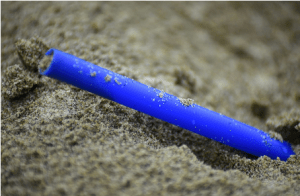Anahita Kodali, Life Sciences, News, Spring 2020
Figure 1: The debate about single-use plastic straws has been a particularly popular and passionate debate all over social media, prompting major retailers – like Starbucks – to shift from use of plastic straws to more ecofriendly lids.
Image Source: Wikimedia Commons
The amount of plastic pollution currently in our oceans is not just an environmental problem, but a global crisis. In 2016, the world produced more than 320 million tons of plastic, a quantity that is set to double in just the next 14 years. Every single day, in some form or another, 8 million pieces of plastic enter our oceans. 1 Researchers estimate that there is currently 269,000 tons of plastic floating around in the open ocean; this number accounts for both macro plastics (larger pieces of plastic) and microplastics (plastics that degraded to less than 5mm in size). 1 There are several reasons that plastic pollution is problematic. First, seabirds and marine animals can ingest it, or get entangled in it, resulting in suffocation, infection, or drowning. Furthermore, plastics can bioaccumulate in marine food webs, posing risks to both animals and humans who consume seafood. 2
Now, researchers are trying to see just how far plastic pollution has spread. Two studies, both completed by scientists from the British Antarctic Survey, have produced datasets regarding the plastics ingested by seabirds and where the plastics originally came from; they are able to determine this by looking at packaging information and chemical analysis. They particularly emphasize the amounts of plastic in the world’s polar regions and the impacts that this plastic has on the environment. The first study, led by Dr. Claire Waldua, a marine ecologist, investigated the amounts of plastic pollution in two polar islands: Bird Island and Signy Island. Her team found that there has been an increase in plastic debris washing up on the shores in recent years. 3She points out that on top of the overall amount of debris increasing, the amount of microplastics has also increased, indicating that much of the plastic found washed up on the islands had been in the ocean for quite some time, suggesting that the plastics had traveled from far away locations in order to reach the polar regions. 4
The second study, headed by seabird ecologist Professor Richard Phillips, studied plastic ingestion by three types of albatrosses (a species of seabird) on Bird Island, South Georgia – wandering albatrosses, giant petrels, and black-browed albatrosses5. The team chose to study these birds because they have a higher tendency to ingest inedibles – like plastics – than other types of birds. 4 They categorized the different types of debris by place of origin, type, color, and size, and they found that the three different types of birds had ingested different types of debris. Wandering albatrosses and giant petrels, which are both scavengers that often take trash from vessels, had high proportions of food wrapping from South America. The third bird, black-browed albatrosses, had ingested relatively low amounts of plastic, indicating that the waters and beaches in South Georgia where they feed are less impacted by plastic pollution than others. 5Professor Phillips explained that vessels that frequent the Antarctic, like fishing vessels, are a significant contributor to plastics pollution in the Southern Ocean. 4
With these findings in mind, scientists will continue to conduct more research into the migration of plastics into Polar regions. Hopefully in the coming years, they will find that efforts to cut plastic pollution have had a significant impact.
Bibliography
[1] Plastic Pollution – Facts and Figures (n.d.). Surfers Against Sewage. Retrieved from https://www.sas.org.uk/our-work/plastic-pollution/plastic-pollution-facts-figures/
[2] The Problem of Marine Plastic Pollution. (2017, December 20). Clean Water Action. Retrieved from https://www.cleanwater.org/problem-marine-plastic-pollution
[3] Claire M. Waluda, Iain J. Staniland, Michael J. Dunn, Sally E. Thorpe, Emily Grilly, Mari Whitelaw, Kevin A. Hughes. Thirty years of marine debris in the Southern Ocean: Annual surveys of two island shores in the Scotia Sea. Environment International, 2020; 136: 105460 DOI: 10.1016/j.envint.2020.105460
[4] British Antarctic Survey. (2020, April 28). Plastic pollution reaching the Antarctic. ScienceDaily. Retrieved April 30, 2020 from www.sciencedaily.com/releases/2020/04/200428112544.htm
[5] Phillips, R. A., & Waluda, C. M. (2020). Albatrosses and petrels at South Georgia as sentinels of marine debris input from vessels in the southwest Atlantic Ocean. Environment International, 136. doi: https://doi.org/10.1016/j.envint.2019.105443
